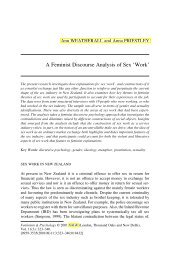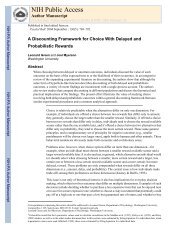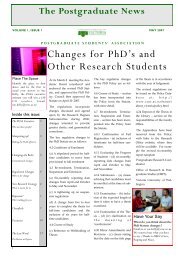Perner 2010.pdf
Perner 2010.pdf
Perner 2010.pdf
You also want an ePaper? Increase the reach of your titles
YUMPU automatically turns print PDFs into web optimized ePapers that Google loves.
Page 246246 <strong>Perner</strong>Going beyond Povinelli’s ChallengeThe problem so far with trying to decide between theories is that for eachtheory-of-mind rule (“S→m→A” CIPs) for a particular action A, a behaviorrule (“S→A” CIP) can be found. That is, both theories explain the sameinput–output function, and no empirical test is possible on these grounds.Moreover, whether we assume that these CIPs are learned or innate, in neithercase are there convincing arguments that behavior rules are more or lesslikely to exist than theory-of-mind rules.Although the input–output functions are the same, the internal structuresof the theories differ. This difference becomes apparent when we look at theinteraction between beliefs and desires (conditions and goals). I illustratethis structural difference with help of the false-belief test used on children(Wimmer & <strong>Perner</strong>, 1983):NOT FOR DISTRIBUTIONA protagonist P puts an object O in location L1. O is unexpectedly transferredin P’s absence to location L2. Children have to predict whether P willgo to L1 or L2 to get O.To give a reasoned answer, something like the following CIPs are required:Mentalist CIPs:S → m:m → A:“IF a person P looks at an object O being put inside a locationL1, and does not look when it is transferred to locationL2, THEN P believes that O is still in L1.”“IF a person P wants to get an object O, and P believes that Ois in location L,THEN P will go to L.”Behavior Rule (SA-CIP): 6S → A:“IF a person P looks at an object O being put inside a locationL1, and does not look when it is transferred to locationL2, AND IF P is 7 to get the object O,THEN P will go to L1.”This example makes clear that there are two elements on the input side.One specifies where the object is seen by the person which gives rise to wherethe person thinks it is (belief-inducing), and the other specifies what the personis supposed to do (response demands, purpose) which gives rise to whatthe person allegedly wants to do (desire-inducing) – namely, to get the object.Perception, attention, and action:International Perspectives on Psychological Science (Volume1). Peter A. Frensch and Ralf Schwarzer (Eds). 2010.Published by Psychology Press on behalf of the International Union of Psychological Science.This proof is for the use of the author only. Any substantial or systematic reproduction,re-distribution, re-selling, loan or sub-licensing, systematic supply or distribution in anyform to anyone is expressly forbidden.15:58:17:03:10Page 246






